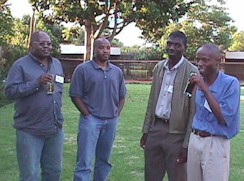
|
RHP |
South African
River Health Programme |

|
River Health Programme (RHP) NCC Meeting & Implementation Workshop 15 and 16 November 2000 Die Grasdak, Pretoria |
|
|
On 15 & 16 November, custodians and provincial implementers of the River Health Programme (RHP) deliberated the road towards national implementation of the programme. The central theme of the two-day event was the creation of an enabling environment to allow internalisation of the RHP within participating organisations. The workshop started with a meeting of the National Coordinating Committee (NCC) of the programme. During this meeting each Provincial Champion reported on RHP activities that has taken place in his/her region. It was clear that significant progress has been made in most provinces, including advances in institutional collaboration and the execution of health surveys on various rivers. What was also striking is that each provincial initiative has its own character as far as adoption and implementation of the RHP goes. This character is seemingly introduced through factors such as the style of the local leadership, resource realities within a particular province, and the degree of inclusiveness and institutional composition of the provincial implementation team. As part of the current “anchoring phase” of the RHP (funded by the DWAF), a number of processes are being developed to assist implementers with operational application of the programme. These include procedures for quality control and continued improvement; a tool (Rivers Database) for data storage and management; and procedures for information packaging and dissemination. Further aims of the anchoring phase are to respond to specific training needs and to ensure effective coordination and communication of new developments and implementation activities around the country. The workshop concluded with a session during which provincial teams expressed their priorities for 2001 regarding implementation of the RHP. These priorities reflected the rich diversity in provincial “make-up” and confirmed the value of flexible implementation models. Where the next step for one province may be to achieve multi-organisational collaboration through formation of a PIT, another province has a need to collate and capture all available river health data, while some provinces have reached the stage were they can produce a “state-of-rivers” report for a particular river system(s). The levels of leadership, enthusiasm and creativity that are evidently present in provincial implementation teams, together with the committed support from national custodian organisations (DWAF, WRC and DEAT), holds a promise of many RHP highlights in 2001.
|
